
What are the chances, that one day you receive a call, and someone on the other end says …
“I’ve got a friend and he’s got an old Mustang, and it’s one with the Hemi head motor in it and wanted to know if you’d be interested in it?”
If you said, “Pretty damn slim!”, you’re pretty damn right!
According to our friends at HotRod.com, that’s exactly what happened one evening in good ol’ Alabama when Charlie Lyons, owner of Charlie’s Classic Cars in Irvington, received a call from a contact looking to help a mate.
“We own a restoration shop and we are known for buying collector cars in any form or fashion, whether it is a project or a completed car.” says Charlie
The Hemi Head he’s referring to is the very rare Boss429 engine that appeared for a short run on the ’69 and ’70 mustangs.
A mega barn find by any definition – I know, the term is now used more loosely and less literally than the days when classics were literally found in barns, but the essence of the find is still the same!
In this case though, the car was being prepared as a show car, and in fact had already appeared in some classic displays. It was still under resto-mod, but had to be put away as the owner had a serious medical condition and couldn’t complete.
That was in the ’80’s, so it had been in hibernation for almost 30 yrs before seeing the light of day once more. It’s amazing what a preservative 30 yrs of dust can be sometimes !
After carefully lowering the car off it’s jacks and onto the ground, Charlie was surprised that three of four tires still held air and more surprised that the brakes had not locked up due to lack of lubricant and airflow pressure.
The pleasant surprises continued when it was found that the Boss 429 was largely intact, although some items were missing, and the body of the car was flawless, with no signs of dreaded rust or panel damage. Even better than that, the factory paint was perfectly protected under an added coat of pearl-infused clear. This is called a Flow Coat and was a form of paint protection in the ’80’s that provided a thicker coat of clear with a little paint mixed in to protect the original paint from scratches and minor dings. I can tell you from experience, that’s an excellent paint protection solution but obviously more expensive than the various polish based offerings today.
Charlie began a minor update with New-Old-Stock or Period-Correct aftermarket replacement, and a fiberglass replacement of the original hood (carbon fibre would have been the logical replacement for me albeit more expensive), and the underside showed a fully painted flawless finish in gloss black after a clean-up.
Most importantly though, the big block Boss429 motor is right there in the engine bay in all it’s numbers-matching glory !
It’s missing some items as we can tell from the photos, such as the carburetor, exhaust manifolds, and distributor, but these can be replaced with period correct items, or other branded mods.
The interior is also intact and largely original, but of course some minor items missing also.
Ford have actually verified the car as being a genuine Boss 429, one of 499 built in 1970, and one of only 13 painted in the color of Calypso Coral with a white interior.
Interestingly, this is the fourth of that combination of 13, known to exist.
According to it’s Marti Report, it has a build date of October 28, 1969 and we know that at the time, Ford built these cars on their assembly line, then shipped them to Kar Kraft in Brighton, MI for their final conversion, and for the serial number assignment. This one is KK# 2315 and was delivered to the lucky original owner in Mobile Alabama!
According to Charlie, the current owner has only mild rather than wild plans for the car, and intends to tidy the engine bay a little, sort out any driveability issues and keep the car under wraps.
Here are some tech notes that are known about the car;
Engine:
- Engine is a numbers-matching Boss429.
- At one point a hotter Crane camshaft was added with an eye towards racing.
- The distributor was also partially installed as part of the camshaft installation.
- Also added was an MSD Blaster 2 coil and Holley fuel pump.
- Missing is the power steering pump which was standard on all Boss 429s, as well as the original radiator, rev limiter, voltage regulator, shock tower brace, and smog pump.
- The previous owner was on a mission to add chrome under the hood so the radiator fan finger guard, the oil cooler bracket, and hood hinges were all plated. Aluminum pieces under the hood like the valve covers and intake were also treated to a full polish. The original air cleaner assembly is also a distant memory on this car. Based on a photo taken back in 1988, it appears that it had an aftermarket triangular mesh air cleaner.
Induction:
- The only induction system available on these cars came down to a cast aluminum, dual-plane, high-rise intake manifold and a Holley 735cfm four-barrel carburetor.
- The original intake was at some point removed and polished and the factory-installed Holley carburetor replaced with a Holley 850 double-pumper.
Transmission:
- Ford kept it simple with the Boss 429 when it came to shifting. The only available gearbox was the Toploader four-speed manual. This Boss still has its original gearbox in place, however, a performance clutch and pressure plate with a Lakewood blowproof bellhousing were installed.
Rearend:
- All Boss 429 engines came equipped with Ford’s bulletproof 9-inch rear. This one still has its original 3.91 Traction-Lok rear in place.
Chassis/suspension:
- All Boss 429 engines came equipped with a “competition suspension” which consisted of unique spring seats, coil springs and a .85-inch sway bar.
- At the rear, the heavy-duty leaf springs are still in place, as is the .625-inch sway bar. The bulk of the suspension was left unmolested, except for the addition of a set of Lakewood traction bars and Competition Engineering bolt-on subframe connectors. The factory-installed hydraulic shocks were also set aside and replaced with Konis.
Brakes:
- Braking on the Boss 429 in 1970 was identical to that of the Boss 302. That consisted of 11.3-inch vented rotors up front, and 10 x 2-inch drums at the rear. These are still in place.
Exhaust:
- The exhaust was at some point removed. Another common swap done back in the ’80s was to toss the factory cast iron exhaust manifolds and replace them with headers. This Boss 429 is wearing a set of rusty Hedman headers and custom pipes front to back.
Wheels/Tires:
- There was only one wheel / tire combo available on the Boss 429 in 1970; they all rolled off the line wearing chrome Magnum 500s wrapped in F60-15 Goodyear Polyglas GTs. On this Boss those were replaced with Centerline Champ 500 aluminum wheels and BF Goodrich Radial T/A tires at some point during the ’80s.
Paint/body:
- The body on this Boss 429 is remarkably straight and rust-free without any signs of collision damage at any point, however, there are a few items that were replaced along the line. The most obvious swap is the original hood. The one currently on the car is a fiberglass replacement, while the scoop is original to the car.
- These 429-equipped cars were nose heavy and we think that choice was made to reduce front-end weight.
- The rear valance also appears to have been swapped for one with cutouts for a dual exhaust.
- This Boss429 rolled off the Dearborn assembly line wearing Calypso Coral, which was one of five factory colors available in 1970. All indications point to it still being the original coat applied at the factory, however, it was at some point over sprayed with a clearcoat mixed with pearl. This is known as a Flow-Coat as mentioned previously
- The rear tail panel, door mirrors, and lower portions of the body were also sprayed in gloss black, and pinstriping was added over the wheel arches. At the back of the car, a rear spoiler was also added, while the Mustang script that ran the length of the trunk lid was removed in favor of a smaller one centrally placed, and the fuel filler cap was replaced.
- At the front, fog lights were added above the license plate frame, and rally-style wire mesh headlight guards were added over the headlights.
- Underneath, this Boss is painted gloss black and is in immaculate condition.
Interior:
- One of the few options available in 1970 on the Boss 429 was a choice of either black or white interior colors, up from only black in 1969.
- Standard on all 1970 models was a center console, Hurst T-handle shifter, Philco AM radio, electric clock, 8,000-rpm tach, rim-blow steering wheel, and simulated teak wood inserts.
- This car was originally delivered with a white interior, which is still in place right down to the mint White Knit Vinyl Dcor bucket seats.
- Much of what was done reflects common interior upgrades that many car owners did back in the ’80s. The AM radio swap is perhaps the most common on vehicles from that era. In this case a Radio Shack Realistic AM/FM radio with a cassette player and graphic equalizer were the choice to replace the stock Philco unit. That upgrade also usually went hand-in-hand with the installation of aftermarket speakers, which would often be installed in the doors and the package tray, as was the case with this car.
- All the factory gauges were swapped-out with Stewart Warner units after the car was parked, so actual mileage is a complete mystery, however, a good indicator of how much usage a car saw can often be determined by the wear on the pedals, and this one shows very little.
- The rim-blow steering wheel was also ditched in favor of a Grant GT removable wheel; this according to Charlie was done to prevent theft of the car. Additional items missing are the console and factory Hurst T-handle shifter, which was swapped with another Hurst shifter.
- The carpet also seems to have been replaced when the console was removed, and the teak wood inserts were sprayed in black.
All in all, this is an excellent reminder that cars like this classic, are still out there .. parked long term in a garage, stored in a shed, or buried in an actual barn. The excitement is in the unearthing of these sleeping beauties, and deciphering the story packed into these time machines!










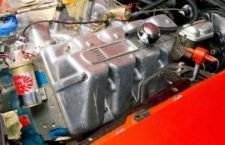

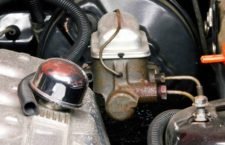
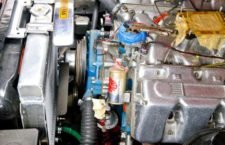











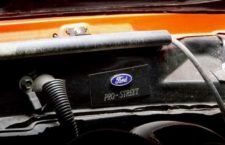














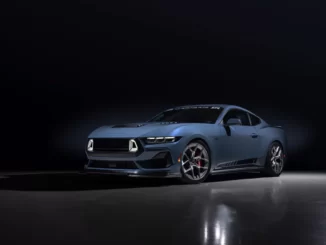
Be the first to comment